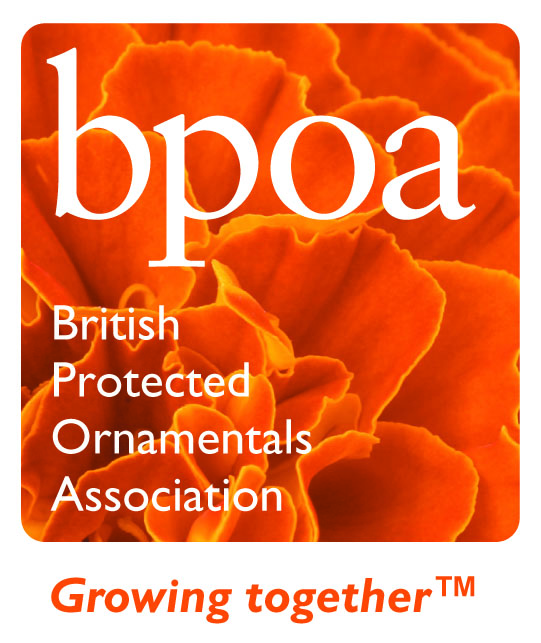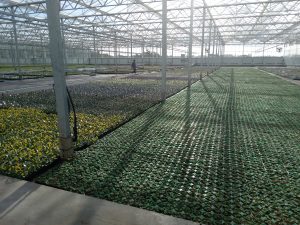Hills plants Workshop
Based on various materials or blends of materials including coir, wood fibre and bark, peat-reduced and peat-free products are now available from all the major growing media manufacturers.
Trials have shown most of these products can perform as well as peat-based media if they are managed appropriately. Understanding the cultural management requirements of these products is therefore key to getting the most from them.
These workshops build on the Defra/AHDB/industry-funded five year project CP138 ‘Transition to responsibly sourced growing media use within UK horticulture’ and form part of the AHDB-funded Bedding and Pot Plant Centre project output.
Delivered by ADAS Horticulture and facilitated by the BOA, they offer practical advice on managing peat alternative products in propagation (Earley Ornamentals) and pot plant crops (Hills).
Introducing the session, Chris Need gave an overview of the current environment in which growers find themselves with regard to the proposed changes in government’s requirements for peatland management and the fundamental change in retailers’ attitude to payment for the increased cost of plants grown in ‘peat-free’ growing media. This change in the market together with the manufacturers’ improvements in growing media formulation, now make it possible for growers to plan ahead with confidence, their routes to ‘peat-free’ plant production.
The meeting this week at Hill’s Plants in Chichester was led by Jill England of ADAS who has directed the trials and presented a brief review of CP138 and the progress so far. Jill covered the development by ADAS of the tool for making graphical comparisons of the physical characteristics of growing media components. This initiative promoted the means to move away peat and towards high-performing non-peat growing media. From this information which is available to manufacturers, it is possible to screen various mixes to assess their suitability for particular purposes, cultures and crops. In the course of the research over the last five years, first second and third generation prototype blends have been made and compared in various commercial nurseries and at the BPPC site at Baginton Nursery.
You can find the papers regarding the growing media tool and the ADAS Growing Media Service here:
Paul Alexander of Bulrush Horticulture gave a short presentation of the manufacturer’s view of progress to date in the project. Speaking specifically about the needs for commercial growers Paul stated mixes must include growing media that is sustainable, reliable and predictable. His current assessment of the total UK market (amateur and commercial) was ~5M m3 of which ~3M m3 was non-peat materials, consisting largely of woodfibre, coir and bark, as well as small but increasing volumes of materials such as AD fibre, green compost and even clay. The chemical amendments have to be adjusted and Paul noted that as the need for lime in peat composts had been reduced, it was necessary to supplement calcium and magnesium which would otherwise become deficient more easily.
Paul noted the new ‘Responsibility Index’ released at GLEE this year, rating amateur, bagged growing media on a scale A-E. Ths is a further attempt by manufacturers to indicate to gardeners what impacts their choices are having on the wider environment. In his closing- ‘take home’ message, he pointed out the significance again of the development of peat culture taking over 90 years and the replacement with alternatives will take time and careful monitoring by commercial growers to obtain suitable alternative methods.
The final, ‘grower’s perspective’ was given by Laura Marner of Hill’s Plants who explained how they had used the 3 proprietary mixes they have been given in comparison with their own peat-free standard mix. Potting of the FIcus Benjamina and Calathea plants had been made 5 weeks earlier and all the plants looked to be growing well. Laura compared the response to the mixes and commented that the purple labelled plants were in a medium that stayed wet too long and consequently the root development was somewhat delayed. A question was raised as to the inclusion of this mix which could be seen from the raw data had a high bulk density and was likely to behave in this way. Obviously, the trials will not be finally assessed until the end of January but the important point is that even using some sub-optimal mixes for this particular culture, more information may be obtained about the way that growers can handle these newer mixes can be produced. It also illustrates the means whereby growers can analyse and specify with their manufacturers, which mixes will be suitable for them. Luke Lloyd also mentioned that they needed to be able to make a limited, ideally one, mix that would suit all types of crop, in all seasons, grown in several different container sizes and with several different glasshouses and irrigation systems.



